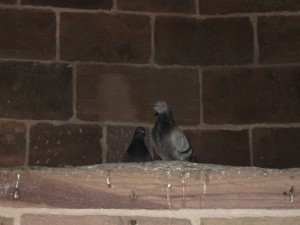When we think about pests affecting schools, animals such as cockroaches and mice typically come to mind. But what if larger critters such as Canada geese, squirrels, bats, woodchucks, or pigeons become troublesome? IPM works for them too. You must, however, be aware of laws that apply to nuisance wildlife and how they might affect your IPM plan.

Canada geese are protected by the Migratory Bird Treaty Act, but there are still things you can do to manage them. Harassing them (such as with dogs or lasers) does not need a permit. Interfering with their nest — such as addling their eggs — does need a permit. When in doubt, contact the DEC.
In New York, the regulatory players involved are the NYS Department of Environmental Conservation (all species) and the U.S. Fish and Wildlife Service (migratory birds and federally endangered and threatened species). Through these agencies, every wildlife species in the state has a legal classification. What is of utmost concern is determining whether your nuisance is classified as “unprotected” or “protected.”
Legal Classification: Unprotected
Unprotected mammals include shrews, moles, bats (except Indiana bats, which are federally protected), chipmunks, woodchucks, red squirrels, flying squirrels, voles, mice, and Norway rats. Unprotected bird species include rock doves (feral pigeons), house sparrows, and European starlings.

Rock doves have no legal protections, but other laws, such as pesticide regulations, firearm discharge ordinances, and trespassing laws, must be followed.
An unprotected species can legally be taken by the property owner at any time of year and by any means as long as other laws (i.e., pesticide regulations, firearm discharge ordinances, trespassing laws, etc.) are not violated. The DEC defines taking as pursuing, shooting, hunting, killing, capturing, trapping, snaring or netting wildlife and game, or performing acts that disturb or worry wildlife.
Some might consider it too cruel to take an animal and decide that capturing your nuisance pest with a live trap is best. Before heading to the hardware store, recognize that you cannot release an animal off your property without a permit. An unprotected animal can be released on the same property where it was captured or must be killed and buried or cremated.
Legal Classification: Protected
For some protected species, if an individual animal is causing damage (not merely being a nuisance), it can be taken by the property owner. Mammals that fall under this category include opossums, raccoons, weasels, and gray squirrels. (Skunks may legally be taken if they are only a nuisance, even if they are not causing damage.) But the animal, dead or alive, cannot be transported off the landowner’s property without a nuisance wildlife control permit obtained from the DEC.

Identification matters. Grey squirrels are protected, while red squirrels are unprotected.
A few mammals (including bear, beaver, deer, mink, and muskrat), most birds, and (currently) all reptiles and amphibians are not only protected but cannot be captured or removed from the property without special case-by-case permits.
Animals with a legal hunting or fur trapping season can be taken as long as the proper hunting or trapping license has been obtained.
Nuisance Wildlife Control Permits
Nuisance wildlife control permits are issued to people who have gone through the prescribed application process. These permits allow protected species to be taken in any number, at any time, and from any location — with permission of the landowner — within the state. Permits must be renewed annually. Private nuisance wildlife control operators, pest control operators dealing with nuisance wildlife, municipal animal control officers, and some wildlife rehabilitators must obtain the proper permits.
Laws change, so if you have a question concerning the legal status of a species or contemplated action, contact the Wildlife section of the regional office of the NYS Department of Environmental Conservation.
For information on IPM for nuisance wildlife, refer to Beasts Begone!: A Practitioner’s Guide to IPM in Buildings and Best Practices for Nuisance Wildlife Control Operators.
(Adapted from Legal Framework for Nuisance Wildlife Control in New York State by Lynn Braband, NYS Community IPM Program at Cornell University)






